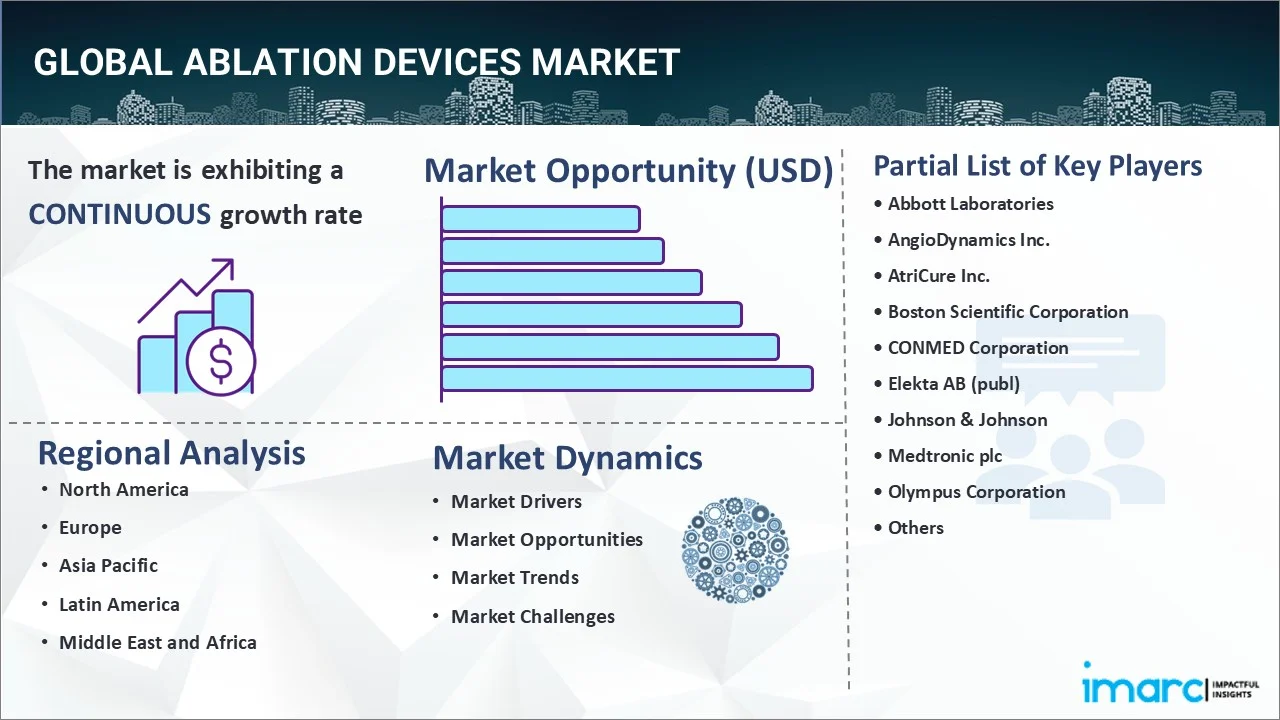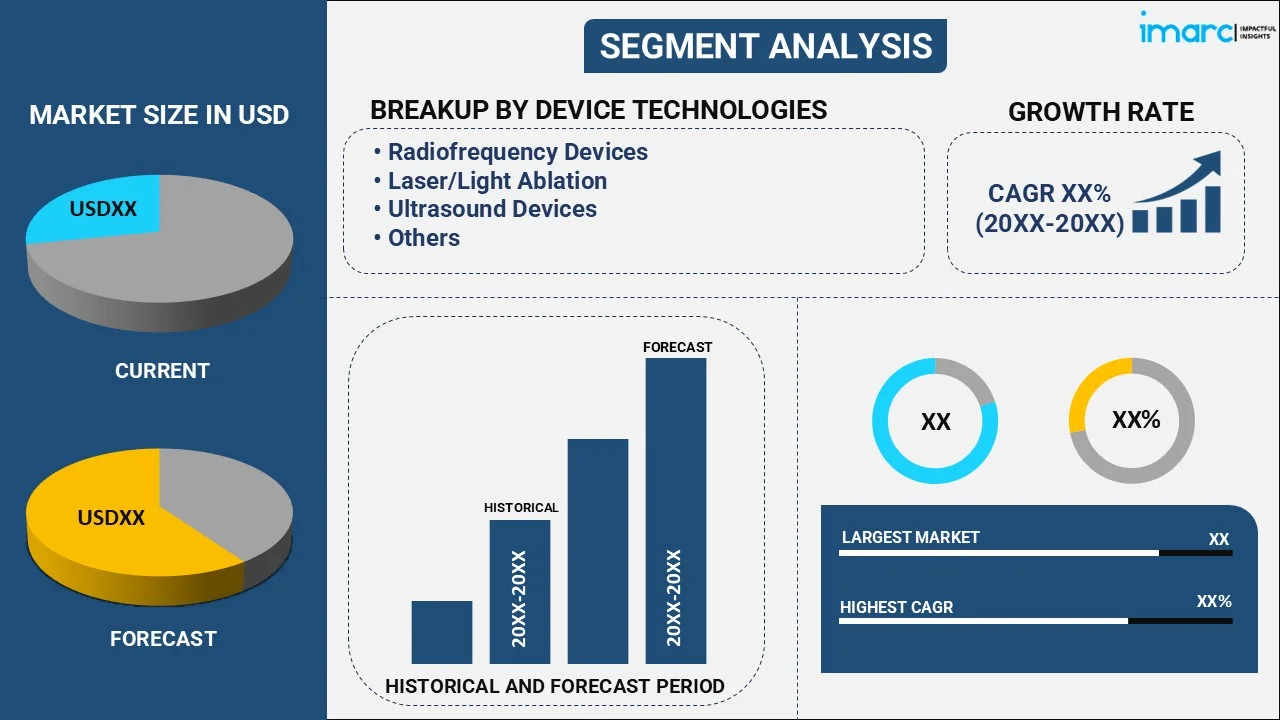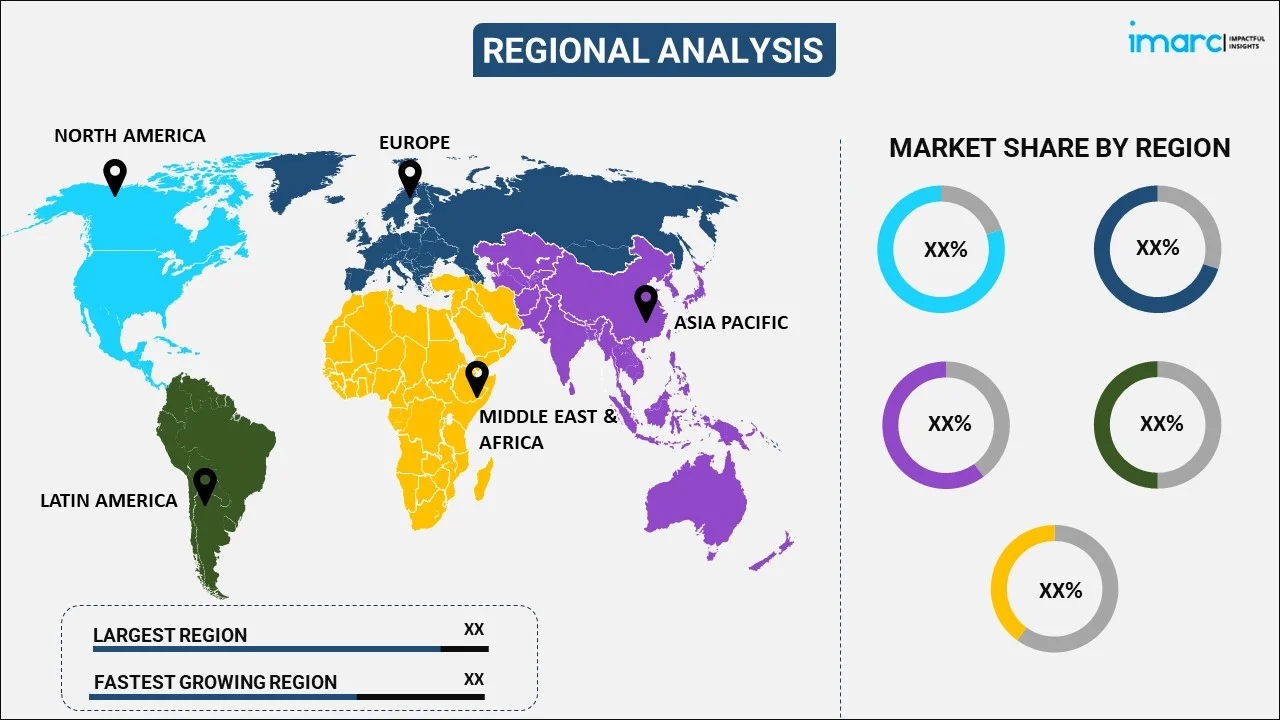
Ablation Devices Market Report by Device Technology (Radiofrequency Devices, Laser/Light Ablation, Ultrasound Devices, Cryoablation Devices, and Others), Application (Cancer Treatment, Cardiovascular Disease Treatment, Ophthalmologic Treatment, Gynecological Treatment, Urological Treatment, Cosmetic Surgery, and Others), End User (Hospitals, Ambulatory Surgical Centers, and Others), and Region 2025-2033
Market Overview:
The global ablation devices market size reached USD 6.5 Billion in 2024. Looking forward, IMARC Group expects the market to reach USD 15.5 Billion by 2033, exhibiting a growth rate (CAGR) of 9.7% during 2025-2033. The increasing prevalence of life-threatening diseases, the widespread adoption of electrophysiology to remove abnormal tissues, and the development of next-generation ablation devices with robotic navigation systems represent some of the key factors driving the market.
|
Report Attribute
|
Key Statistics
|
|---|---|
|
Base Year
|
2024
|
|
Forecast Years
|
2025-2033
|
|
Historical Years
|
2019-2024
|
|
Market Size in 2024
|
USD 6.5 Billion |
|
Market Forecast in 2033
|
USD 15.5 Billion |
| Market Growth Rate (2025-2033) | 9.7% |
Ablation devices are medical instruments or tools used in various medical procedures to remove or destroy tissue, typically with the goal of treating or managing certain medical conditions. These devices work by delivering energy, such as heat, cold, or radiofrequency, to the targeted tissue, causing its removal or alteration. Ablation procedures are minimally invasive and are often preferred over traditional surgical methods because they typically result in less pain, shorter recovery times, and reduced risk of complications.

The market is experiencing growth driven by several key factors, including the increasing prevalence of life-threatening diseases such as cancer, atrial fibrillation, and chronic venous insufficiency (CVI). This rise in disease incidence underscores the demand for effective ablation procedures. Furthermore, the growing awareness among the public about the availability of minimally invasive ablation techniques is propelling market expansion. These procedures offer numerous advantages, including reduced pain, minimal scarring, decreased discomfort, and quicker patient recovery times. Additionally, the widespread adoption of electrophysiology procedures to address irregular heart rhythms and cardiac arrhythmia by removing abnormal tissues is contributing significantly to market growth. Besides, manufacturers are also responding to evolving medical needs by creating non-thermal, non-tumescent, and non-sclerosant endovenous ablation devices tailored for the effective treatment of superficial vein reflux.
Ablation Devices Market Trends/Drivers:
Increasing prevalence of life-threatening diseases
Cancer remains one of the leading causes of death worldwide, with a rising incidence in recent years. Ablation procedures, particularly in oncology, have gained prominence as minimally invasive alternatives to surgery. They are employed to destroy cancerous tissues in various organs, such as the liver, kidney, and lung. Moreover, CVI is a condition where veins in the legs fail to adequately return blood to the heart, leading to pain, swelling, and skin changes. Endovenous ablation procedures are now commonly used to treat CVI by closing off malfunctioning veins. The rising incidence of CVI, often associated with lifestyle factors and aging, has driven the demand for ablation devices designed for venous treatments.
Widespread adoption of electrophysiology
Electrophysiology is a branch of cardiology that deals with the electrical activity of the heart. It has witnessed a surge in adoption due to its effectiveness in diagnosing and treating various cardiac arrhythmias, including atrial fibrillation. Electrophysiology-guided ablation procedures involve precisely locating and eliminating the source of abnormal electrical signals in the heart. This approach has become the standard of care for many heart rhythm disorders, offering patients a chance for symptom relief and improved quality of life. Moreover, with healthcare professionals increasingly recognizing the benefits of electrophysiology-guided ablation, its adoption has become widespread, leading to a growing demand for related ablation devices and equipment.
Integration of next-generation ablation devices with robotic navigation systems
The advancement of technology in the field of ablation devices is a significant driving force. Next-generation ablation devices incorporate robotic navigation systems, which enhance precision, accuracy, and procedural outcomes. Robotic-assisted ablation allows for more controlled and targeted tissue ablation, reducing the risk of complications and improving patient outcomes. These robotic systems provide real-time imaging and mapping of the treatment area, enabling healthcare providers to navigate complex anatomical structures with greater confidence. As a result, the adoption of these advanced ablation devices is on the rise, particularly among healthcare facilities looking to offer state-of-the-art treatment options. The promise of improved patient safety and procedural success rates further fuels the demand for these devices.
Ablation Devices Industry Segmentation:
IMARC Group provides an analysis of the key trends in each segment of the global ablation devices market report, along with forecasts at the global, regional, and country levels from 2025-2033. Our report has categorized the market based on device technology, application and end user.
Breakup by Device Technology:

- Radiofrequency Devices
- Laser/Light Ablation
- Ultrasound Devices
- Cryoablation Devices
- Others
Radiofrequency devices represent the most used device technology
The report has provided a detailed breakup and analysis of the market based on the device technology. This includes radiofrequency devices, laser/light ablation, ultrasound devices, cryoablation devices, and others. According to the report, radiofrequency devices represented the largest segment.
RF ablation has demonstrated effectiveness across a wide range of medical applications. It is used to treat conditions such as cardiac arrhythmias (e.g., atrial fibrillation), liver tumors, kidney tumors, and chronic pain management. This versatility makes RF technology a go-to choice for physicians dealing with various medical specialties. Moreover, RF ablation has a long history of safe and successful use in medical procedures. The technology has been refined over the years, and clinicians have extensive experience with its application. This track record of safety and efficacy instills confidence in both healthcare providers and patients.
Breakup by Application:
- Cancer Treatment
- Cardiovascular Disease Treatment
- Ophthalmologic Treatment
- Gynecological Treatment
- Urological Treatment
- Cosmetic Surgery
- Others
Cancer treatment holds the largest market share
A detailed breakup and analysis of the market based on the application has also been provided in the report. This includes cancer treatment, cardiovascular disease treatment, ophthalmologic treatment, gynecological treatment, urological treatment, cosmetic surgery, and others. According to the report, cancer treatment represented the largest segment.
Cancer is a widespread and prevalent disease that affects millions of people globally. It can occur in various organs and tissues, leading to a high demand for effective treatment options. As the incidence of cancer continues to rise due to factors like aging populations and lifestyle changes, the need for cancer treatment methods, including ablation, remains significant. Moreover, ablation techniques have proven to be versatile in the field of oncology. These procedures can be used to treat both primary tumors and metastatic lesions, making them applicable across different stages and types of cancer. Ablation can be employed in various organs, such as the liver, kidney, lung, and bone, providing clinicians with a wide range of treatment options.
Breakup by End User:
- Hospitals
- Ambulatory Surgical Centers
- Others
Hospitals accounts for majority of market share
A detailed breakup and analysis of the market based on the end user has also been provided in the report. This includes hospitals, ambulatory surgical centers, and others. According to the report, hospitals represented the largest segment.
Ablation procedures often require specialized equipment and trained medical professionals. Hospitals are well-equipped to handle complex medical interventions and have the necessary infrastructure, including operating rooms, imaging technology, and support staff, to perform these procedures safely and effectively. This makes hospitals the natural choice for patients seeking ablation treatments. Moreover, hospitals house a wide range of medical specialties, including cardiology, oncology, gastroenterology, urology, and more. Ablation devices are used across multiple medical disciplines to treat various conditions. Hospitals can offer a comprehensive suite of ablation services, making them a one-stop destination for patients with diverse medical needs.
Breakup by Region:

- North America
- United States
- Canada
- Asia-Pacific
- China
- Japan
- India
- South Korea
- Australia
- Indonesia
- Others
- Europe
- Germany
- France
- United Kingdom
- Italy
- Spain
- Russia
- Others
- Latin America
- Brazil
- Mexico
- Others
- Middle East and Africa
North America exhibits a clear dominance in the market
The market research report has also provided a comprehensive analysis of all the major regional markets, which include North America (the United States and Canada); Europe (Germany, France, the United Kingdom, Italy, Spain, Russia, and others); Asia Pacific (China, Japan, India, South Korea, Australia, Indonesia, and others); Latin America (Brazil, Mexico, and others); and the Middle East and Africa. According to the report, North America accounted for the largest market share.
North America, particularly the United States and Canada, boasts a highly developed and advanced healthcare infrastructure. The region is home to world-renowned medical institutions, hospitals, and research centers. This advanced infrastructure provides a solid foundation for the adoption of cutting-edge medical technologies, including ablation devices. Moreover, the region has one of the highest healthcare expenditure rates in the world. This substantial investment in healthcare, both by governments and private entities, enables the procurement of state-of-the-art medical equipment, including ablation devices. It also supports research and development efforts in the healthcare sector, leading to innovation and product advancements.
Competitive Landscape:
The competitive landscape of the market is characterized by the presence of multiple players that include established brands, emerging startups, and specialty manufacturers. Presently, leading companies are allocating significant resources to research and development efforts to develop innovative and technologically advanced ablation devices. This includes the development of next-generation ablation systems with enhanced precision, safety features, and user-friendly interfaces. They are also expanding their product portfolios to offer a comprehensive range of ablation devices catering to various medical specialties and applications. This includes devices designed for cardiac ablation, oncology, pain management, gynecology, and more. Moreover, companies are expanding their reach into new geographical markets. This expansion involves obtaining regulatory approvals and certifications in different regions, establishing distribution networks, and adapting their products to meet specific regional requirements.
The market research report has provided a comprehensive analysis of the competitive landscape. Detailed profiles of all major companies have also been provided. Some of the key players in the market include:
- Abbott Laboratories
- AngioDynamics Inc.
- AtriCure Inc.
- Boston Scientific Corporation
- CONMED Corporation
- Elekta AB (publ)
- Johnson & Johnson
- Medtronic plc
- Olympus Corporation
- Smith & Nephew plc
(Please note that this is only a partial list of the key players, and the complete list is provided in the report.)
Recent Developments:
- Abbott has made notable developments in the field of ablation devices. They have introduced the EnSite Precision™ cardiac mapping system, which offers high-resolution imaging and accurate mapping of the heart. This technology enables precise identification of abnormal tissue during ablation procedures, improving the success rate of the treatment.
- Johnson & Johnson has been actively involved in the development of innovative ablation technologies. It has introduced the TactiCath Contact Force Ablation Catheter, which provides real-time feedback on the amount of force applied during cardiac ablation procedures. This helps in achieving better outcomes and reducing the risk of complications.
- Medtronic Plc have introduced the Arctic Front Advance Cryoballoon System, which is used for the treatment of atrial fibrillation. This system offers improved efficiency and precision in cardiac ablation procedures.
Ablation Devices Market Report Scope:
| Report Features | Details |
|---|---|
| Base Year of the Analysis | 2024 |
| Historical Period | 2019-2024 |
| Forecast Period | 2025-2033 |
| Units | Billion USD |
| Scope of the Report | Exploration of Historical Trends and Market Outlook, Industry Catalysts and Challenges, Segment-Wise Historical and Future Market Assessment:
|
| Device Technologies Covered | Radiofrequency Devices, Laser/Light Ablation, Ultrasound Devices, Cryoablation Devices, Others |
| Applications Covered | Cancer Treatment, Cardiovascular Disease Treatment, Ophthalmologic Treatment, Gynecological Treatment, Urological Treatment, Cosmetic Surgery, Others |
| End Users Covered | Hospitals, Ambulatory Surgical Centers, Others |
| Regions Covered | Asia Pacific, Europe, North America, Latin America, Middle East and Africa |
| Countries Covered | United States, Canada, Germany, France, United Kingdom, Italy, Spain, Russia, China, Japan, India, South Korea, Australia, Indonesia, Brazil, Mexico |
| Companies Covered | Abbott Laboratories, AngioDynamics Inc., AtriCure Inc., Boston Scientific Corporation, CONMED Corporation, Elekta AB (publ), Johnson & Johnson, Medtronic plc, Olympus Corporation, Smith & Nephew plc, etc. |
| Customization Scope | 10% Free Customization |
| Post-Sale Analyst Support | 10-12 Weeks |
| Delivery Format | PDF and Excel through Email (We can also provide the editable version of the report in PPT/Word format on special request) |
Key Benefits for Stakeholders:
- IMARC’s industry report offers a comprehensive quantitative analysis of various market segments, historical and current market trends, market forecasts, and dynamics of the ablation devices market from 2019-2033.
- The research report provides the latest information on the market drivers, challenges, and opportunities in the global ablation devices market.
- The study maps the leading, as well as the fastest-growing, regional markets. It further enables stakeholders to identify the key country-level markets within each region.
- Porter's five forces analysis assist stakeholders in assessing the impact of new entrants, competitive rivalry, supplier power, buyer power, and the threat of substitution. It helps stakeholders to analyze the level of competition within the ablation devices industry and its attractiveness.
- Competitive landscape allows stakeholders to understand their competitive environment and provides an insight into the current positions of key players in the market.
Key Questions Answered in This Report
The global ablation devices market was valued at USD 6.5 Billion in 2024.
We expect the global ablation devices market to exhibit a CAGR of 9.7% during 2025-2033.
The rising prevalence of cancer, atrial fibrillation, and Chronic Venous Insufficiency (CVI), along with the growing adoption of minimally invasive ablation procedures, as they cause lesser pain, scarring, and discomfort and promote faster recovery, is primarily driving the global ablation devices market.
The sudden outbreak of the COVID-19 pandemic had led to the postponement of elective invasive ablation surgical procedures to reduce the risk of the coronavirus infection upon hospital visits and interaction with medical equipment, thereby negatively impacting the global market for ablation devices.
Based on the device technology, the global ablation devices market can be segmented into radiofrequency devices, laser/light ablation, ultrasound devices, cryoablation devices, and others. Currently, radiofrequency devices hold the majority of the total market share.
Based on the application, the global ablation devices market has been divided into cancer treatment, cardiovascular disease treatment, ophthalmologic treatment, gynecological treatment, urological treatment, cosmetic surgery, and others. Among these, cancer treatment currently exhibits a clear dominance in the market.
Based on the end user, the global ablation devices market can be categorized into hospitals, ambulatory surgical centers, and others. Currently, hospitals account for the largest market share.
On a regional level, the market has been classified into North America, Asia-Pacific, Europe, Latin America, and Middle East and Africa, where North America currently dominates the global market.
Some of the major players in the global ablation devices market include Abbott Laboratories, AngioDynamics Inc., AtriCure Inc., Boston Scientific Corporation, CONMED Corporation, Elekta AB (publ), Johnson & Johnson, Medtronic plc, Olympus Corporation, and Smith & Nephew plc.
Need more help?
- Speak to our experienced analysts for insights on the current market scenarios.
- Include additional segments and countries to customize the report as per your requirement.
- Gain an unparalleled competitive advantage in your domain by understanding how to utilize the report and positively impacting your operations and revenue.
- For further assistance, please connect with our analysts.
 Request Customization
Request Customization
 Speak to an Analyst
Speak to an Analyst
 Request Brochure
Request Brochure
 Inquire Before Buying
Inquire Before Buying




.webp)




.webp)












